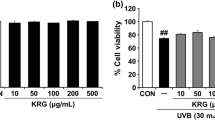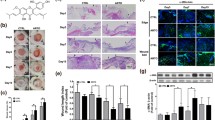Abstract
The restoration of the epidermal epithelium through re-epithelialization is a critical process in wound healing. Directed keratinocyte migration to the wound is required, and the retardation of this process may result in a chronic, non-healing wound. The present study contributes to research aiming to identify promising compounds that promote wound healing using a human keratinocyte model. The effects of three kaempferol glycosides from an Afgekia mahidoliae leaf extract, kaempferol-3-O-arabinoside, kaempferol-3-O-glucoside, and kaempferol-3-O-rutinoside, on keratinocyte migration were determined. Interestingly, kaempferol-3-O-rutinoside exhibited a pronounced effect on wound closure in comparison to the parental kaempferol and other glycosides. The mechanism by which kaempferol-3-O-rutinoside enhances cell migration involves the induction of filopodia and lamellipodia formation, increased cellular levels of phosphorylated FAK (Tyr 397) and phosphorylated Akt (Ser 473), and up-regulation of active Rac1-GTP. The data obtained in this study may support the development of this compound for use in wound healing therapies.







Similar content being viewed by others
References
Gurtner GC, Werner S, Barrandon Y, Longaker MT (2008) Wound repair and regeneration. Nature 453:314–321
Mitra SK, Hanson DA, Schlaepfer DD (2005) Focal adhesion kinase: in command and control of cell motility. Nat Rev Mol Cell Biol 6:56–64
Enciso JM, Konecny CM, Karpen HE, Hirschi KK (2010) Endothelial cell migration during murine yolk sac vascular remodeling occurs via a Rac1 and FAK activation pathway in vivo. Dev Dyn 239:2570–2583
Mitra SK, Schlaepfer DD (2006) Integrin-regulated FAK-Src signaling in normal and cancer cells. Curr Opin Cell Biol 18:516–523
Larsen M, Tremblay ML, Yamada KM (2003) Phosphatases in cell-matrix adhesion and migration. Nature 4:705–706
Sepp KJ, Auld VJ (2003) RhoA and Rac1 GTPases mediate the dynamic rearrangement of actin in peripheral glia. Development 130:1825–1835
Hsu CL, Muerdter CP, Knickerbocker AD, Walsh RM, Zepeda-Rivera MA, Depner KH, Sangesland M, Cisneros TB, Kim JY, Sanchez-Vazquez P, Cherezova L, Regan RD, Bahrami NM, Gray EA, Chan AY, Chen T, Rao MY, Hille MB (2012) Cdc42 GTPase and Rac1 GTPase act downstream of p120 catenin and require GTP exchange during gastrulation of zebrafish mesoderm. Dev Dyn 241:1545–1561
Nobes CD, Hall A (1995) Rho, Rac, and cdc42 GTPases regulate the assembly of multimolecular focal complexes associated with actin stress fibers, lamellipodia, and filopodia. Cell 81:53–62
Burridge K, Chrzanowska-Wodnicka M (1996) Focal adhesions, contractility, and signaling. Annu Rev Cell Dev Biol 12:463–518
Rottner K, Hall A, Small JV (1999) Interplay between Rac and Rho in the control of substrate contact dynamics. Curr Biol 9:640–648
Burtt BL, Chermsirivathana C (1971) A second species of Afgekia (Leguminosae). Note R Bot Gard Edinburgh 31:131–133
Chainok K (2007) Isolation of antioxidant components from petroleum ether extract of Afgekia mahidolae Burtt et Chermsir. leaves. Master’s thesis, Department of Pharmacognosy, Faculty of Pharmacy, Mahidol University
Ambiga S, Narayanan R, Durga G, Sukumar D, Madhavan S (2007) Evaluation of wound healing activity of flavonoids from Ipomoea carnea Jacq. Anc Sci Life 26:45–51
Clericuzio M, Tinello S, Burlando B, Ranzato E, Martinotti S, Cornara L et al (2012) Flavonoid oligoglycosides from Ophioglossum vulgatum L. having wound healing properties. Plant Med 78:1639–1644
Said A, Hawas UW, El-Shenawy S, Nofal SM, Rashed K (2010) Flavonoids and some biological activities of Ailanthus excels leaves. Istanbul Universitesi Fen Fakultesi Biyoloji Dergisi J Biol 69:41–55
Deng S, Deng Z, Fan Y, Peng Y, Li J, Xiong D, Liu R (2009) Isolation and purification of three flavonoid glycosides from the leaves of Nelumbo nucifera (Lotus) by high-speed counter-current chromatography. J Chromatogr B 877:2487–2492
Leong CNA, Tako M, Hanashiro I, Tamaki H (2008) Antioxidant flavonoid glycosides from the leaves of Ficus pumila L. Food Chem 109:415–420
Liang CC, Park AY, Guan JL (2007) In vitro scratch assay: a convenient and inexpensive method for analysis of cell migration in vitro. Nat Protoc 2:329–333
Gao ZX, Huang DY, Li HX, Zhang LN, Lv YH, Cui HD (2010) Scutellarin promotes in vitro angiogenesis in human umbilical vein endothelial cells. Biochem Biophys Res Commun 400:151–156
Walter MN, Wright KT, Fuller HR, Macneil S, Johnson WE (2010) Mesenchymal stem cell-conditioned medium accelerates skin wound healing: an in vitro study of fibroblast and keratinocyte scratch assays. Exp Cell Res 316:1271–1281
Santoro MM, Gaudino G (2005) Cellular and molecular facets of keratinocyte reepithelization during wound healing. Exp Cell Res 304:274–286
Ranzato E, Patrone M, Mazzucco L, Burlando B (2008) Platelet lysate stimulates wound repair of HaCaT keratinocytes. Br J Dermatol 159:537–545
Huttenlocher A, Horwitz AR (2011) Integrins in cell migration. Cold Spring Harb Perspect Biol 3:1–2
Morozevich GE, Kozlova NI, Ushakova NA, Preobrazhenskaya ME, Berman AE (2012) Integrin α5β1 simultaneously controls EGFR-dependent proliferation and Akt-dependent pro-survival signaling in epidermoid carcinoma cells. Aging 4:368–373
Xia H, Nho RS, Kahm J, Kleidon J, Henke CA (2004) Focal adhesion kinase is upstream of phosphatidylinositol 3-kinase/Akt in regulating fibroblast survival in response to contraction of type I collagen matrices via β1 integrin viability signaling pathway. J Biol Chem 279:33024–33034
Shukla S, MacLennan GT, Hartman DJ, Fu P, Resnick MI, Gupta S (2007) Activation of PI3K-Akt signaling pathway promotes prostate cancer cell invasion. Int J Cancer 127:1424–1432
Kong M, Munoz N, Valdivia A, Alvarez A, Herrera-Molina R, Cardenas A, Schneider P, Burridge K, Quest AF, Leyton L (2013) Thy-1-mediated cell-cell contact induces astrocyte migration through the engagement of αvβ3 integrin and syndecan-4. Biochim Biophys Acta 1833:1409–1420
Zhang Z, Yang M, Chen R, Su W, Li P, Chen S, Chen Z, Chen A, Li S, Hu C (2013) IBP regulates epithelial-to-mesenchymal transition and the motility of breast cancer cell via Rac1, RhoA and Cdc42 signaling pathways. Oncogene 33:3374–3382
Li J, Zang S, Soto X, Woolner S, Amaya E (2013) ERK and phosphoinositide 3-kinase temporally coordinate different modes of actin-based motility during embryonic wound healing. J Cell Sci 126:5005–5017
Park KY, Lee SH, Min BK, Lee KS, Choi JS, Chung SR, Min KR, Kim Y (1999) Inhibitory effect of luteolin 4′-O-glucoside from Kummerowia striata and other flavonoids on interleukin-5 bioactivity. Plant Med 65:457–459
Salama MM, Ezzat SM, Sleem AA (2011) A new hepatoprotective flavone glycoside from the flowers of Onopordum alexandrinum growing in Egypt. Z Naturforsch C 66:251
Habtemariam S (2013) Antihyperlipidemic components of Cassia auriculata aerial parts: identification through in vitro studies. Phytother Res 27:152–155
Yeung BHY, Wong CKC (2011) Stanniocalcin-1 regulates re-epithelialization in human keratinocytes. PLoS One 6:1–9
Serrels B, Serrels A, Brunton VG, Holt M, McLean GW, Gray CH, Jones GE, Frame MC (2007) Focal adhesion kinase controls actin assembly via a FERM-mediated interaction with the Arp2/3 complex. Nat Cell Biol 9:1046–1056
Gates RE (1994) Potential role for focal adhesion kinase in migrating and proliferating keratinocytes near epidermal wounds and in culture. Cell Grow Differ 5:891–899
Tureckova J, Vojtechova M, Krausova M, Sloncova E, Korinek V (2009) Focal adhesion kinase functions as an Akt downstream target in migration of colorectal cancer cells. Transl Oncol 2:281–290
Zhao X, Guan JL (2011) Focal adhesion kinase and its signaling pathways in cell migration and angiogenesis. Adv Drug Deliv Rev 63:610–615
Raftopoulou M, Hall A (2004) Cell migration: Rho GTPases lead the way. Dev Biol 265:23–32
Sander EE, ten Klooster JP, van Delft S, van der Kammen RA, Collard JG (1999) Rac downregulates Rho activity: reciprocal balance between both GTPases determines cellular morphology and migratory behavior. J Cell Biol 147:1009–1022
Acknowledgments
This research was financially supported by the Ratchadapiseksomphot Endowment Fund of Chulalongkorn University (RES560530157-HR), the 90th Anniversary of Chulalongkorn University Fund (Ratchadapiseksomphot Endowment Fund), and the Unit Cell for Research and Development of Herbs and Natural Products for Dental Application, Chulalongkorn University. We would like to acknowledge Associate Professor Rutt Suttisri, Ph.D. for his help in the isolation process. We also thank the Chulalongkorn University Centenary Academic Development Project for providing the facility used for this research.
Author information
Authors and Affiliations
Corresponding authors
Rights and permissions
About this article
Cite this article
Petpiroon, N., Suktap, C., Pongsamart, S. et al. Kaempferol-3-O-rutinoside from Afgekia mahidoliae promotes keratinocyte migration through FAK and Rac1 activation. J Nat Med 69, 340–348 (2015). https://doi.org/10.1007/s11418-015-0899-3
Received:
Accepted:
Published:
Issue Date:
DOI: https://doi.org/10.1007/s11418-015-0899-3




